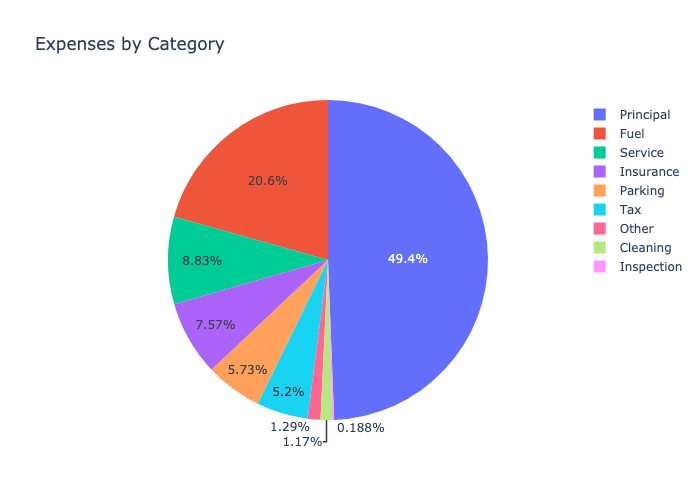Are you ever confronted with the thought of how much it actually costs to own a car? Well, I did, and I had to find out.
For a period of approximately 6 years, between 2016 and 2022 (specifically, 2 269 days), I saved all receipts related to my car. Everything from the down payment, petrol, parking to parking violation tickets, annual service and ferry boat tickets.
First, a breakdown of my expenses by category. Around half of all car expenses went to paying for the actual car, followed by fuel (20%), servicing (9%), insurance (8%), and parking (6%). The rest is taxes, car washes, motor vehicle inspection and miscellaneous.

Zooming in on the parking expenses over time, I have 433 recorded parking occations. In July of 2018 I moved back home to Stockholm and used the car much more, and it seems like my parking expenses increase a lot during summers. In late spring of 2020, I avoided public transportation by carpooling to work with my sister. I have no recollection of what happened in January of 2022, but there sure was a spike in activity there.
There are some main players that provide solutions for parking payments in Sweden. The firm Easypark allows for paying in streetparking everywhere in Stockholm and in select garages. Basically, they take a fee for every transaction through the app, but you can extend or shorten the parking duration which either (1) saves you money by only paying for the time you use or (2) saves you effort by not having to run to the car to extend the parking duration. So, Easypark is the parking firm that I have interacted with the most.
As I write this, fuel prices are down to 18 SEK/L (6.5 USD/gal). This is a very decent price. For the period where I have receipts, the maximum price was 23.73 SEK/L (8.5USD/gal) and the minimum was 11.89 SEK/L (4.3 USD/gal)
If I compare my fuel prices versus a national average, I more often than not fuel up at a price slightly lower than the national average daily price.
My cumulative fuel consumption in expenses and volume looks as follows. For my car, this total volume is equivalent to around 102 full tanks. On average, I fuel 32 litres per time, and my absolute maximum was 42.55 litres.
As a persion of habit, I will drive the extra mile (literally), to get to my favorite gas station. The gas chain Ingo is the second-closest to me when I live in Stockholm, but is always cheaper than the one that is closest, and is usually on my way in any case. When I lived in Uppsala, the cheapest gas station was St1.
I was recently asked why I gather statistics about my life and what pleasure, if any, I get out of it. These are all small challenges that I pose to myself, and I only take them seriously while I’m doing them. This project of analyzing car expenses is officially concluded, and now I look back at it with insight, wisdom and accomplishment.
At some points, I have to remind myself that the measurements are secondary to the actual activity. There is a real danger in optimizing measurements at the cost of living. Or to focus so much on measurements because they provide a sense of accompolishment that you forget that the underlying performance is the whole reason these measurmenets are possible.
I will always, first and foremost, live my life to the fullest. If I happen to record some of it, or try to understand it better, that is just a plus. Stay stats-freaky friends!
Uploaded 2024–02–16; Last updated 2024–02–16